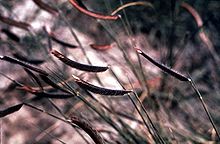| Blue grama | |
|---|---|

| |
| Scientific classification | |
| Kingdom: | Plantae |
| Clade: | Tracheophytes |
| Clade: | Angiosperms |
| Clade: | Monocots |
| Clade: | Commelinids |
| Order: | Poales |
| Family: | Poaceae |
| Genus: | Bouteloua |
| Species: | B. gracilis
|
| Binomial name | |
| Bouteloua gracilis | |
Bouteloua gracilis, the blue grama, is a long-lived, warm-season (C4) perennial grass, native to North America.[2][4][5]
It is most commonly found from Alberta, Canada, east to Manitoba and south across the Rocky Mountains, Great Plains, and U.S. Midwest states, onto the northern Mexican Plateau in Mexico.
Blue grama accounts for most of the net primary productivity in the shortgrass prairie of the central and southern Great Plains. It is a green or greyish, low-growing, drought-tolerant grass with limited maintenance.[6]
- ^ NatureServe (2023). "Bouteloua gracilis Blue Grama". NatureServe Explorer. Arlington, Virginia: NatureServe. Retrieved 28 April 2023.
- ^ a b USDA, NRCS (n.d.). "Bouteloua gracilis". The PLANTS Database (plants.usda.gov). Greensboro, North Carolina: National Plant Data Team.
- ^ "Bouteloua gracilis". International Plant Names Index (IPNI). Royal Botanic Gardens, Kew; Harvard University Herbaria & Libraries; Australian National Botanic Gardens.
- ^ "Bouteloua gracilis". County-level distribution map from the North American Plant Atlas (NAPA). Biota of North America Program (BONAP). 2014. Retrieved July 13, 2018.
- ^ "Bouteloua gracilis". State-level distribution map from the North American Plant Atlas (NAPA). Biota of North America Program (BONAP). 2014. Retrieved July 13, 2018.
- ^ Smoliak, S.; Ditterline, R.L.; Scheetz, J.D.; Holzworth, L.K.; Sims, J.R.; Wiesner, L.E.; Baldridge, D.E.; Tibke, G.L. "Blue Grama (Bouteloua gracilis)". Montana Interagency Plant Materials Handbook. Montana State University Extension Service. Archived from the original on June 10, 2010.
